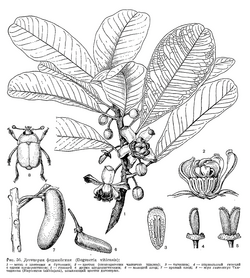| Degeneria | |
|---|---|
 | |
| Degeneria vitiensis | |
| Scientific classification | |
| Kingdom: | Plantae |
| Clade: | Tracheophytes |
| Clade: | Angiosperms |
| Clade: | Magnoliids |
| Order: | Magnoliales |
| Family: | Degeneriaceae I.W.Bailey & A.C.Sm. [1] |
| Genus: | Degeneria I.W. Bailey & A.C.Sm. |
| Species | |
Degeneria is a genus of flowering plants endemic to Fiji. It is the only genus in the family Degeneriaceae. The APG IV system of 2016 (unchanged from the APG system of 1998, the APG II system of 2003 and the APG III system of 2009), recognizes this family, and assigns it to the order Magnoliales in the clade magnoliids. [1] [2]
Contents
Degeneria was named after Otto Degener, who first found D. vitiensis in 1942. Classical studies of native stands of Degeneria from Vanua Levu and Viti Levu islands were conducted more than 30 years ago. [3] [4] [5]
A 45-cent stamp issued in 1988 depicted a flowering branch of Degeneria vitiensis. This species appears on Fiji's five-dollar bill. A one-dollar 1988 philatelic commemorated the discovery of Degeneria roseiflora earlier in that same year.
The genus contains two species of trees, both native to Fiji: [6] [7]
- Degeneria roseiflora John M.Mill. – Vanua Levu, Taveuni – karawa
- Degeneria vitiensis L.W.Bailey & A.C.Sm. – Viti Levu – masiratu.